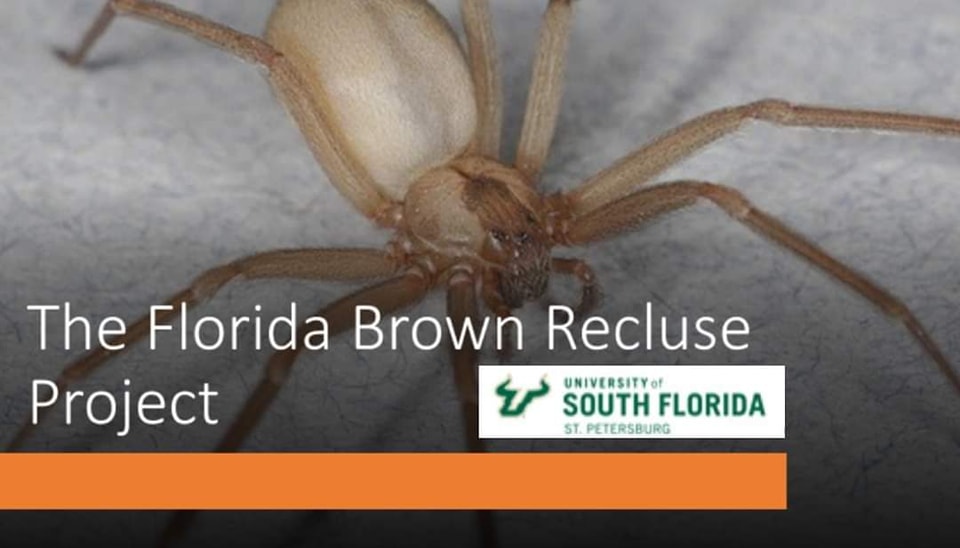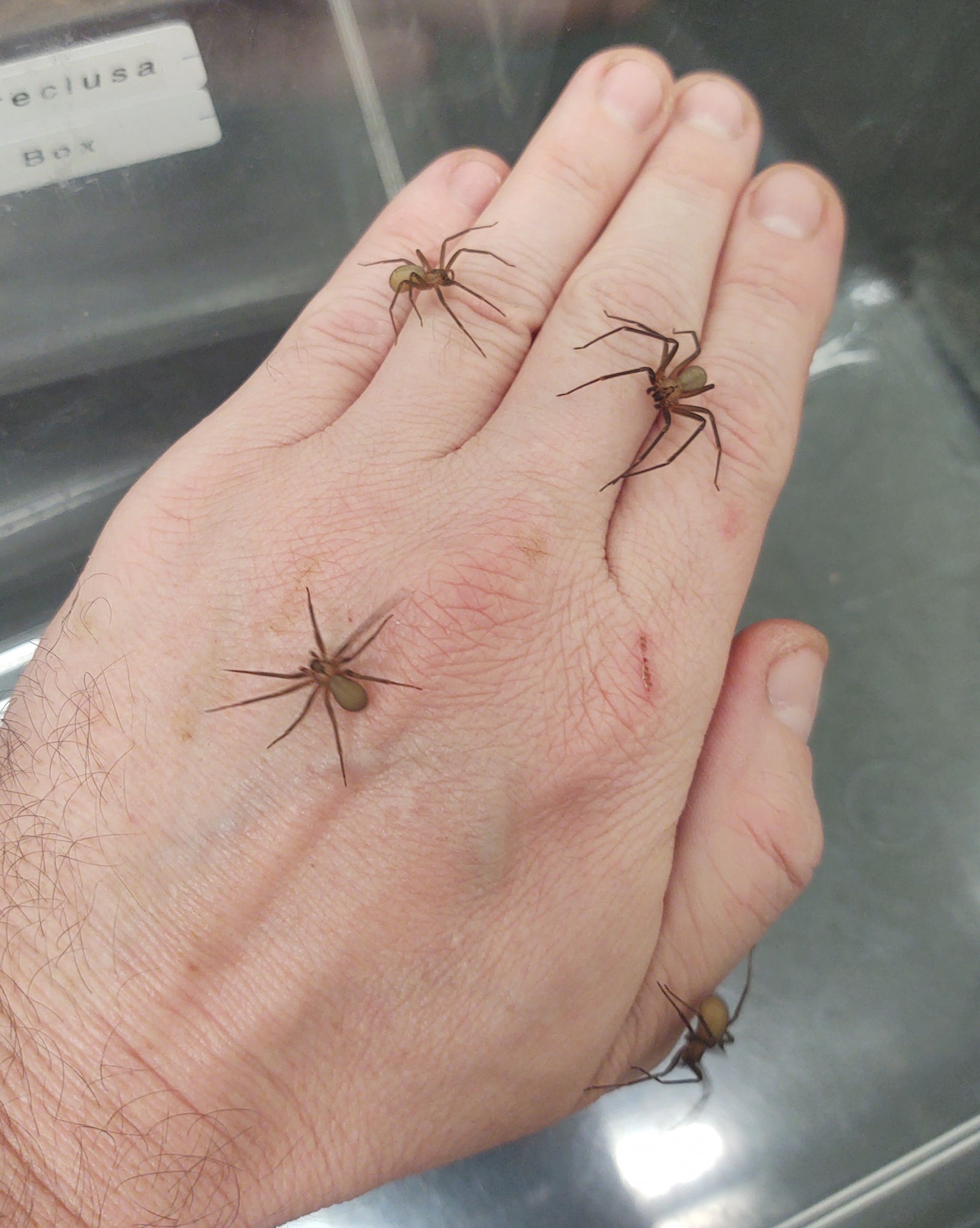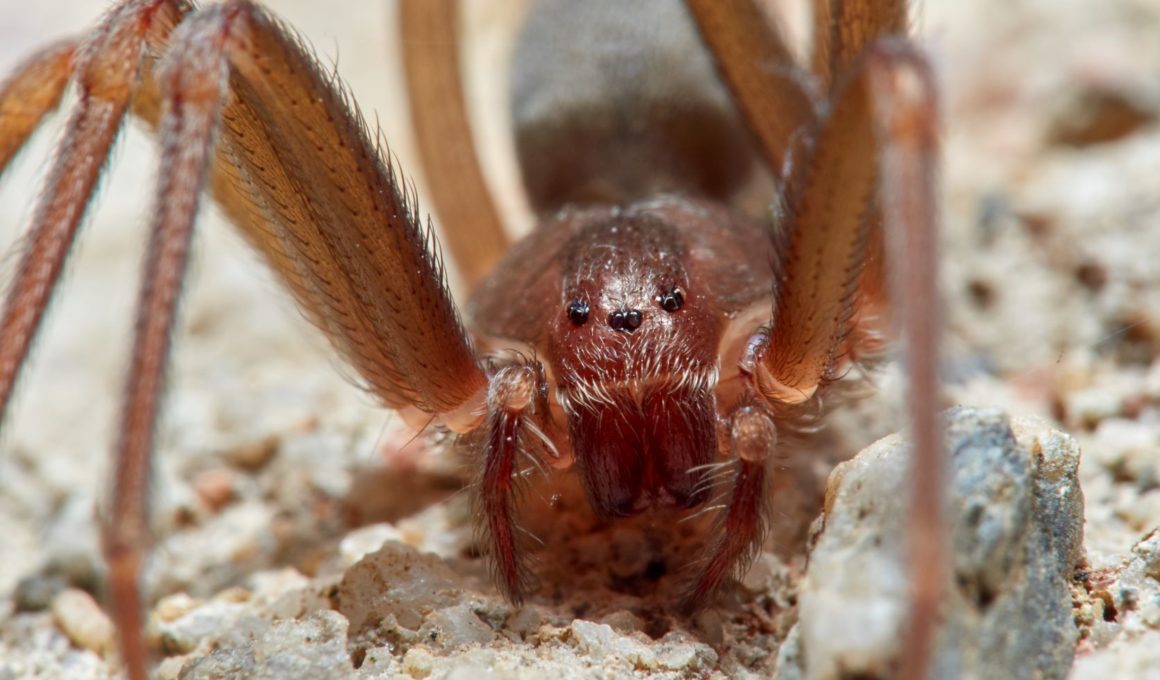
You could call Louis Coticchio Spider-Man but you’re more likely to find him crawling under houses than climbing up skyscrapers. He’s a man with a mission: debunking the myth that brown recluse spiders in Florida cause horrifically painful bites that necrotize into life-threatening wounds.
“In the first place, only about 100 recluse spiders were verified between 1904 and 2018, so less than one spider a year,” Coticchio said. “And then, my most recent experiment shows that Mediterranean recluses – the species most likely to be seen in Florida — are extremely reluctant to bite humans, even when handled.”
A student at the University of South Florida St. Petersburg (USFSP) with 25 years’ experience handling animals, Coticchio has spent the last four years traveling the state looking for recluse spiders, usually following reports of residents being bitten.
“The funny thing is that I’ve found breeding populations of recluse spiders in 20 locations in Florida, where no one has ever experienced a bite, sometimes after cohabiting for 10 to 20 years,” he said. “But no recluses were found at the other 107 locations I’ve visited where people claim to have been bitten or seen a recluse.”
It’s almost the stereotypical chicken-and-egg situation, only backward. Someone gets bit by something, and everyone blames it on a brown recluse. That makes it even more likely that the next time someone gets bit, it must have been another recluse. The trouble is that there is no way to scientifically verify that the bite actually came from a recluse spider.
 Coticchio’s new Facebook page, the Florida Brown Recluse Project, includes contributors from a “who’s-who” of experts in the world of venomous spiders. “We’re trying to dispel some of the myths about not just recluse spiders, but most spiders living on this planet,” he said. “While some species of spiders may be more defensive than others, spiders would much rather avoid people rather than bite. Venom is costly to produce, and wasting it on humans is something that they do only as a final resort when other defensive measures have not worked.”
Coticchio’s new Facebook page, the Florida Brown Recluse Project, includes contributors from a “who’s-who” of experts in the world of venomous spiders. “We’re trying to dispel some of the myths about not just recluse spiders, but most spiders living on this planet,” he said. “While some species of spiders may be more defensive than others, spiders would much rather avoid people rather than bite. Venom is costly to produce, and wasting it on humans is something that they do only as a final resort when other defensive measures have not worked.”
“Lou has an extraordinary passion for spiders,” said Dr. Debi Cassill, his lead research advisor in USFSP’s Department of Integrative Biology. “Within the first five minutes of our meeting, I was ‘two-thumbs up’ about his research ideas and invited him to use my lab over the summer for whatever project he wanted to do.”
After nine years as a zookeeper specializing in venomous animals and having crawled under houses in nearly every county in Florida searching for spiders without a single bite, Coticchio was comfortable saying recluse spiders aren’t likely to bite, but his latest experiment at USF makes it even more clear.
“I used a medical gel to simulate human skin, then created shapes to represent different parts of the body. Using “no-kill” tweezers that squeeze the spider but not hard enough to kill it, I tried to get the spiders to bite. I pinched legs, poked faces, squeezed them from both sides and put pressure on their whole bodies while they were upside down.”
 Even in those extreme circumstances, the spiders bit less than 36% of the time, and then only when they were upside-down and squeezed at the same time, he said. Wolf spiders, often seen in homes and generally considered to be non-aggressive, were more defensive than the recluses but still didn’t bite until they were under intense pressure.
Even in those extreme circumstances, the spiders bit less than 36% of the time, and then only when they were upside-down and squeezed at the same time, he said. Wolf spiders, often seen in homes and generally considered to be non-aggressive, were more defensive than the recluses but still didn’t bite until they were under intense pressure.
Coticchio’s myth-defying research on recluse spiders follows similar work on brown and black widow spiders. It turns out the brown widows are far more aggressive than the black. The non-native brown widows actively hunt and kill the much-shier black widows in the field and the lab, making them more a hazard to native ecosystems than a danger to human beings.
Going forward, he’s looking at how the Mediterranean recluses – typically hitchhikers from international travelers – are arriving in Florida and then dispersing. “Recluse spiders have very low to no dispersal rates, but the Mediterranean recluse may be different,” he said. “We’re looking at that in the lab now, but it’s still highly unlikely that breeding populations will ever be established across the state.”
And for Tampa Bay readers who still live in fear of spider bites: 14 of the 20 breeding populations of Mediterranean recluses Coticchio has found live in St. Augustine, with the only breeding recluses found in the Tampa Bay region living in a home where people had recently returned from Europe.
“They were concentrated in the garage near the luggage and no one has been bitten,” he said.
Spiders, particularly recluse spiders, may have a bad rap but it’s extremely unlikely that Floridians will ever be bit by one, he adds.
Learn more about Coticchio’s research with an online presentation at https://onedrive.live.com/embed?cid=0C6F3BF387573FA8&resid=C6F3BF387573FA8!1387&authkey=AG7BYdKyZ6_QW_s&em=2&fbclid=IwAR0pWFhNejUO-1SpYtmd51L42pEIH0hVSNJdkyX3Wkzvb8bzsR3HbSE2dRA
